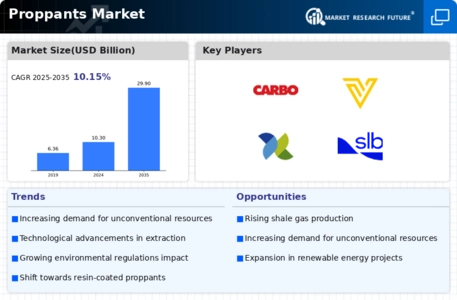Top Industry Leaders in the Proppants Market
 The proppants market, a crucial cog in the oil and gas industry, is experiencing a dynamic shift. Fueled by rising shale gas production and evolving fracturing technologies, This growth, however, is unfolding amidst a complex competitive landscape, where established players and innovative newcomers grapple for market share.
The proppants market, a crucial cog in the oil and gas industry, is experiencing a dynamic shift. Fueled by rising shale gas production and evolving fracturing technologies, This growth, however, is unfolding amidst a complex competitive landscape, where established players and innovative newcomers grapple for market share.
Strategies Shaping the Game:
Product Differentiation: Leaders like Saint-Gobain and CARBO Ceramics are pushing the boundaries of innovation, developing advanced proppants with superior crush strength, conductivity, and chemical resistance. These high-performance proppants, though pricier, cater to complex well conditions and enhance well productivity, securing a premium market segment.
Cost Optimization: Players like U.S. Silica and Hi-Crush are focusing on optimizing production processes, securing low-cost raw materials, and achieving economies of scale. This cost-leadership strategy allows them to offer competitive pricing, particularly attractive in price-sensitive regions like North America.
Geographic Expansion: With the shale boom spreading across continents, major players like Superior Silica Sands and Covia are aggressively expanding their regional footprint. This involves establishing new production facilities, acquiring local players, and forging strategic partnerships to gain access to key markets.
Vertical Integration: Some players, like Halliburton and Schlumberger, are integrating upstream and downstream in the value chain. This allows them to control the entire proppants lifecycle, from sourcing raw materials to offering proppant management services, creating a one-stop solution for oil and gas operators.
Factors Dictating Market Share:
Proppant Type: Frac sand remains the dominant proppant, accounting for over 80% of the market. However, resin-coated and ceramic proppants are gaining traction due to their superior performance in challenging environments. The type of proppant used depends on well depth, formation characteristics, and operator preferences.
Application: Shale gas and tight oil extraction are the primary drivers of proppant demand. However, its use is expanding to other applications like coalbed methane extraction and geothermal energy production. Diversification into new applications offers growth opportunities for proppant manufacturers.
Regional Dynamics: North America, particularly the United States, is the largest proppants market, driven by extensive shale gas activity. However, regions like Asia-Pacific and Latin America are witnessing significant growth due to rising oil and gas exploration and production.
Key Players
-
Carbo Ceramics Inc.
-
COVIA
-
JSC Borovichi Refractories Plant
-
S. Silica Holdings Inc.
-
Hi-Crush Inc.
-
MineraçãoCurimbaba
-
XinmiWanli Industry Development Co. Ltd.
-
Atlas Sand Company
-
Llc
-
HEXION
-
Schlumberger Ltd.
Recent Developments :
August 2023: CARBO Ceramics acquires a proppant manufacturing facility in Canada, expanding its North American presence.
September 2023: Superior Silica Sands announces a joint venture with a Saudi Arabian company to establish a frac sand production plant in the Middle East.
October 2023: The Environmental Protection Agency finalizes new regulations for hydraulic fracturing, potentially impacting proppant demand in the United States.
November 2023: A group of proppant producers forms a consortium to develop standardized testing procedures for proppant performance.
December 2023: The International Energy Agency reports a rebound in global oil and gas investments, indicating positive prospects for the proppants market.









